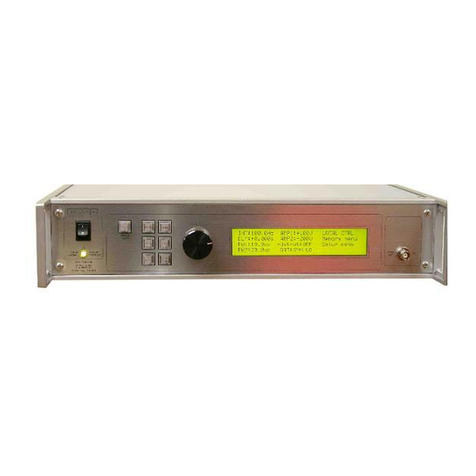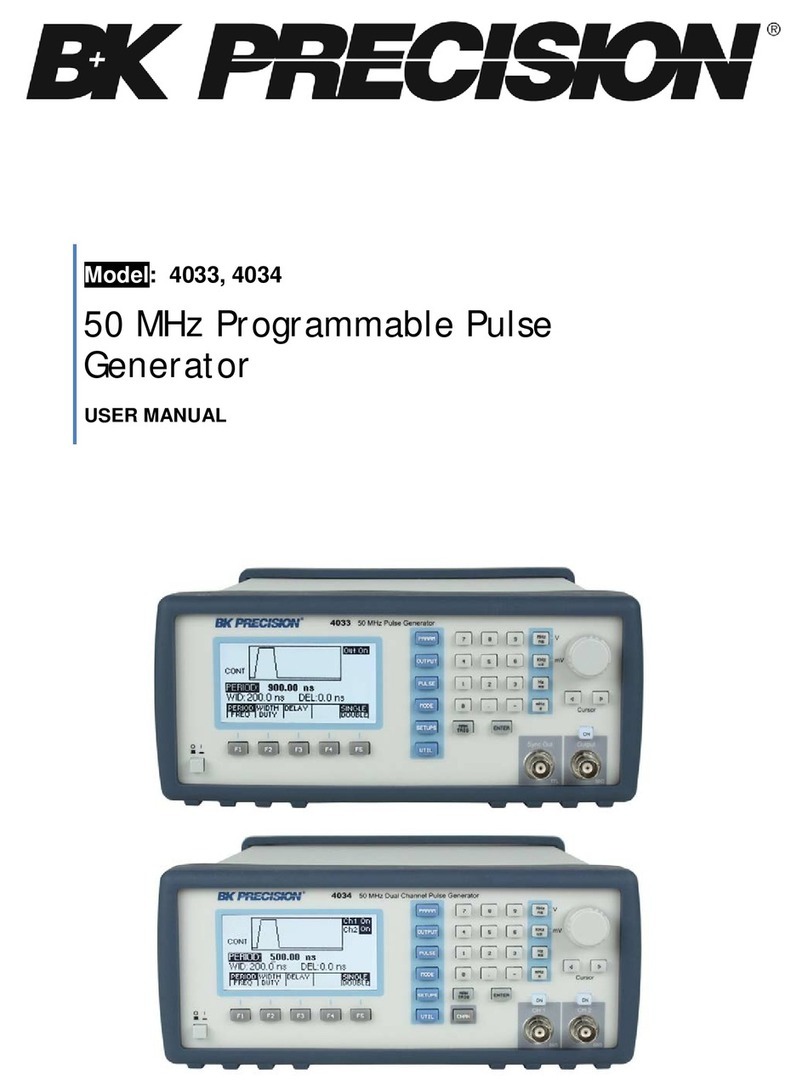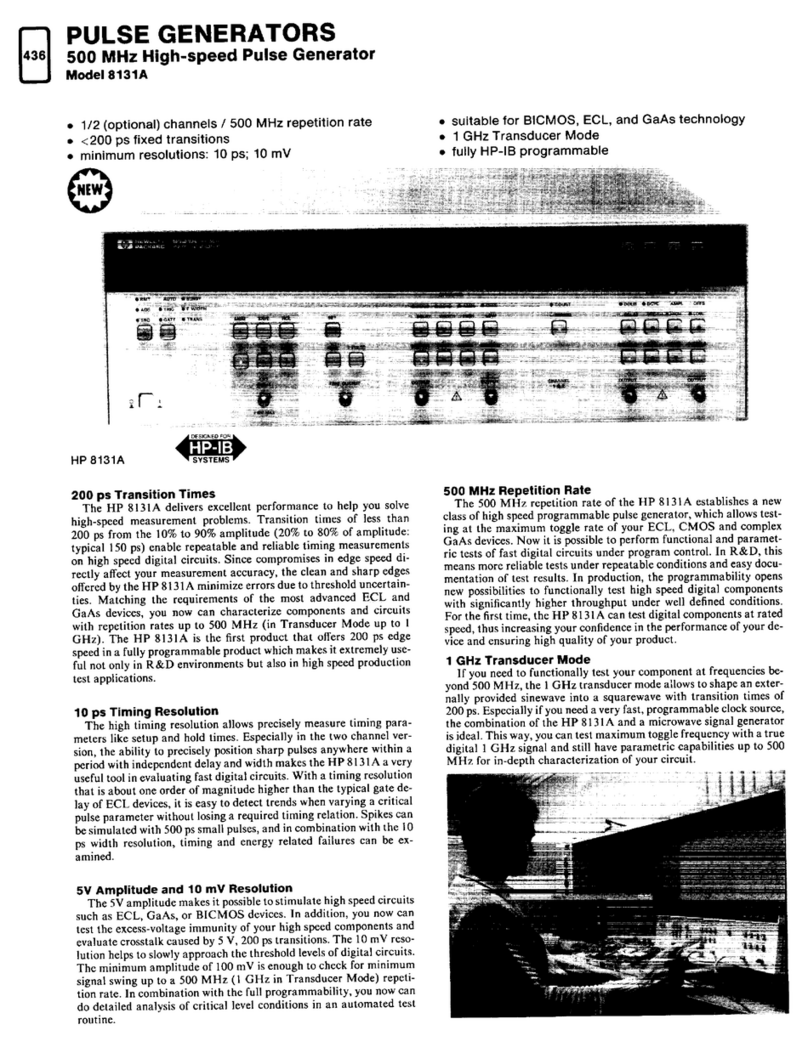Global Specialties 4001 User manual

Tue
4OOl
UnaavARrABLE
PutsE aENERATIR
Operation
Manual
1486HighlandAvenue,
Unit2
Cheshire,
CT06410
(203)27
2-3285 FAX:
(203)27
2-4330

WARRANTY
GlobalSpecialties@warrantsthisdevice
to
be free from defectivematerial or workman-
shipfor aperiod of onefull yearfrom thedate
of originalpurchase.
- GlobalSpecialties@
under this warranty is
limited to repairing thedefective
device
when
returned to the factory,
shipping charges
pre-
paid, within one year from date of original
purchase.
Units returned to GlobalSpecialties@
that
havebeen
subject
toabuse,misuse,
damage
or
accident,
or have
been
connected,installed
or
adjusted
contrary
totheinstructions
furnished
by Global Specialties@,
or that havebeenre-
paired by unauthorizedpersons
will not be
covered
bv thiswarrantv.
Global
Specialties@
reserves
the
righttodis-
continue
models,
change
specifications,
price
or designof this deviceat any time without
notice and without incurring any obligation
whatsoever.
Thepurchaser
agrees
to assume
all liabili
tiesforany
damages
and
/ orbodily inj
urywhich
mayresultfromthe use
ormisuse
of
this
device
by thepurchaser,
hisemployees,
or agents.
This warranty is in lieu of ali representa-
tionsor warranties
expressed
or implied and
no agentor representative
of GlobalSpecial-
ties@
isauthorized
toassume
anyother
oUtiga-
tioninconnectionwiththe
saleand
purchase
of
thisdevice.
FACTORY
SERVICE
AND
Global
Specialties@
will serviceandrepair
thisinstrument
free
of charge
for aperiodof onefull
year,
subjecttothewarranty conditions
above.
Toobtainareturnmerchandise
authorization
(RMA) required
for allreturns,
phone
our
Customer
ServiceDepartment
for anRMA andall shippinginstructions:
Tel.1-800-572-1.028
or write:
GLOBALSPECIALTIES
1486HighlandAvenue,Unit2
Cheshire,CT06410
(203)272-3285
FAX:
(203)272-4330
ATTN: CUSTOMER
SERVICE
DEPARTMENT
BREADBOARDINGSOCKETS
LIFETIME
GUARANTEE
All Global
Specialties@
breadboarding
socketsare
guaranteed
for life. If asocket
everfailsto
meetyour requirements,
return it and we will replace
it,
NO QUESTIONS
ASKED.
Specifications
subjecttochange
without notice.
@
and TM trademarks are the property of INTERPLEX ELECTRONICS, INC., New Haven, CT.


TABLE
OF
CONTENTS
SPECIFICATIONS.. ..PAGE
2
INTRODUCTION..... .PAGE
4
DESCRIPTION....... ..PAGE
4
LOCATION
AND
DESCRIPTION
OF
OPERATING
CONTROLS............PAGE
5
CHECKING
OUT
THE
4OO1 .....PAGE
9
APPLICATIONS..... ...PAGE
14
CIRCUIT
DESCRI
PTION.......
REcALIBRATIoN
PRocEDURE
AND
;usE
nepLACEMENi............
B1BE
??
CIRCUIT
SCHEMATIC.......... ...PAGE
27
SERV|CE
AND
WARRANTY
tNFORMAT|ON..........................................pne
eze
LIST
OF
ILLUSTRATIONS
FIGURE
1. Location
of
Operating
Contro1s............. PAGE
5
FIGURE
2. Run
lMode
and
com[lemented
waveforms.............. pAGE
5
l99l! q Trig
Mode
Waveforms.............. ............PAGE
6
FIGURE
4. Gate
Mode
Waveforms.............. ......,...PAGE
6
FIGURE
5. One-Shot
Mode
Waveforms.............. ...PAGE
6
FIGURE
6. Run
Mode
and
Squared
Waveforms.. ..PAGE
7
FIGURE
Z. Checkout
Configuration.......... ..............PAGE
9
FIGURE
8. Waveforms.............. .............PAGE
10
FIGURE
9. Checking
Trigger
and
Gate
Modes..... .PAGE
14
FIGURE
10.
Missing
pulse
Detector
Apptication.............. .......pAGE
15
II9yl_E11 Amptifier
Frequency
Response
Test......... ..........pAGE
17
FIGURE
12.Transmission
Line
Test... ...PAGE
1g
FIGURE
13. Scope
Waveform
Patterns-Transmission
Line
Testing.......pAGE
20
FIGURE
14.Case
Disassembly
and
Assembty .......PAGE
25
FIGURE
1s.Circuit
Schematic........
. . ..........................:.
.pAGE
27
LIST
OFTABLES
IlPf_E
1.
Typical
square-wave
patterns
and
Interpretation...................pAGE
16
TABLE
2.
Power/Output
Retationships....................:.....
..........pAGE
17

Frequency
Range:
Pulse
Width
and
Spacing
Controls:
Duty
Cycle:
Accuracy:
(Pulse
Width
and
Spacing)
(Amplitude)
Jitter:
Operating
Modes
(pushbu
tton
selectable)
Run:
Trig:
Gate:
One
Shot:
Square
Wave:
4OO1
SPECIFICATIONS
0.5
Hz
to5 MHz
1O0nsec.-1sec
in
7overlapping
ranges.
Independent
variable
width
and
spaiing
controls.
Two
concentric,
single-turn
verniers
provide
continuous
adjustment
between
ranges.
107-to-1
range,
cont.
adjustable
+5%
typical,tlso/o
@
max
vernier
setting.
+5o/oofcontrol
setting.
Less
than
0.1%+S0psec.
0.5
Hz
to5 MHz,
frequency
settable
through
pulse
width/spacing
controls.
DC
toapproximately
10
MHz
from
external
source.
Generator
starts
synchronously
with
leading
edge
ofgate
signal-"One
Shot"
pushbutton
can
manually
activate
gate
in
this
mode.
Enables
manual"One
Shot"
pushbutton.
Square
wave
may
beobtained
atthe
outputs
by
depressing
"Square
Wave"
pushbutton.

Complement:
Trig/Gate
Input:
Output:
Var
Out
TTL
Out:
Sync
Out:
Power:
Operating
Tem
perature:
Size
(WxHxD):
Weight:
Q{guts may
beinverted
by depressing
the
"COMPL"
pushbutton,
without
losing
sync
time
reference.
NOTE:
pulse
spacing
controls
not active
during
"Trigger"
and
"One-Shot"
modes.
TTL
compatible
input,
DC
coupled
logic
input:
pulses>2.4V
peak>4Onsec
wide.
Sine
wave
input:>1.7V
RMS<1OMHz.
Input
impedance:
400Q
max.
input:
r10V.
Amplitude,
0.S-10V,
adjustable
via
single
turn
vernier;
rise/fall
time
3Onsec;
impedande,
50CI
Fan
out,40
TTL
loads;
sink,
64mA
atO.gV
maximum;
rise/fall
time:
less
than
2Onsec.
Amplitude
2.4V
minimum;
fan
out,1O
TTL
loads;
sink,
16mA
atO.8V
maximum;
riseifall
time,
less
than
2Onsec;
sync
pulse
lead
time,
greater
than
2Onsec.
105-125VAC,
50/60
Hz
220-240VAC,
50i60
Hz(Optionat)
0"Cto50"C
(calibrated
at 25"
C t55" C).
32"Fto 122"F
'(calibrate
dal 72"F*9" F).
10"
x3"x7" (254
x76
x 178mm).
2.2tbs.(1
kg)

INTRODUCTION
The
Global
Specialties
4001
Ultravariable
Pulse
Generator
is
a reliable
low
cost
pulse
Generator.
lts
uncomplicated
rugged.design
and
high
quality
components
ensure
long
and
dependable
service.
The
4oo1
offers
these
feaiures:
Separate
TTL
Output
AVariable
Output
from
O.5V
to10V
5QOutput
lmpedance
Pulse
Width
Range
from
lOOnsec
tolsec
DESCRIPTION:
The
Model
4001,
primarily
designed
as
apulse
or
clock
source,
is
compatible
with
lC
and
discrete
component
circuits.
lt
also
finds
application
as
a syste. sieppet
(One-
Shot
Mode),
gated
oscillator
(Gate
Mode),
orprir" stretcher(Tiigger
Mode).
With
a
minimum
ofadjustments,
the
4oo1
can
also
serve
asa missirig
illse detector
ora
frequency
discriminator.
The
output
can
be
complemented
or
converted
to
a square
wave
with
a push
ofthe
button.
The
Model
4001
offers
two
Simultaneous
Independent
Outputs
(TTL
and
Variable)
with
rise
and
fall
times
less
than
30nsec;
2Onsec
TTL
compatible
leading-edge
Sync
pulse
output'
There
are
independent
pulse
width
and
pulse
spacing
controls
(both
selectable
form
lOonsec
to lsec)
eliminating
incompaiible
frequenJy
ano
pulse
width
settings.
Also
on
the
panel
arefour
pushbutton
selectable
operatind
mooe
switches
marked
(Run,
Trigger,
Gate
and
One-Shot).

LOCATION
AND
DESCRIPTION
OF
Refer
toFigure
1
for
thelocation
ofall
operating
referred
tothroughout
the
text.
NOTE
All
pushbutton
switches
are
push-to-activate
switches.
1 2 34
5
'13
12 11 1098
FIGURE
1.
Location
of
Operating
Controls
POWER
Switch
and
LED
Indicator:(1)
MODE
Switch
(2)
NOTE
The
four
Mode
Switches(2)
are
mechanically
interlocked
allowing
only
one
switch
to
be
activated
at
atime.
They
are
designated
RUN,
TRIG
ano
ofr-sHor.
RUN:
In
the
Run
mode,
the4OO1
is
self-oscillating.
All
external
inputs
are
disconnected,
and
all
timing
controls
arefunctional.
(See
figure
Z)
aOpr3^.
20
nsec
1 l* { z.a
VMin.
SyncOut n n n n :n n
I Run
TTLor t-t t-l f-l f-l l-l l-l Mode
Var
Out
TTL
or Complemented
Varour --l l-'l f-] l-] f-l l-l l-
FIGURE
2.Run
Mode
and
Complemented
OPERATING
CONTROLS
controls.
These
numbers
will
be
*rrrorx l-E'|.- -.- -', 5, 1.f. -, 19, /
;Ai.ffi:/n
[( | l]-- aoor eulse GENERAToer ,\-/..
\lZ o^rt[.rc * tY* ar rr! out va. ovr

TRIG:
In
theTrig
mode,
the
4001
outputs
produce
asynchronouspositive
going
output
pulse
for
each
positive
input
trigger.
The
output
pulse
width
is
adjusted
byihe pulse
Width
and
Width
Vernier
controls.
The
output
puise
isinitiated
by
the
posltiu"-.dge
ofthe
input
trigger.
When
the
mode
switch.is
in
theTrigger
mode,
the
pulse
Spacing
and
Spacing Vernier are inactive. (See Figure B) ve' i"v-Y' rrrv ' v'vv
Trig
TTL
or
Var
Oul f
,,,n
Itvtode
FIGURE
3.Trig
Mode
Waveforms.
GATE:
In
the
Gate
mode,
the
4991
outputs
produce
trains
ofpulses
for
the
duration
of
the
appliedgallng
signal.
The
leading
edge
of
the
gating
signal
starts
the
output
pulse
!ai1 The
first
pulse
in
the
train
ii synchronized'witti
teioing
edge
of
the
gating
signat.
Both
thePulse
Spacing
andPulse
wiotn
controls
the
program
pulse
train
parameters.
lf
the
gating
pulse
ends
while
an
output
is
present,
thelaitpulse
will
be
complemented.
(See
Figure
4).
I 2.4VMin
lcate
.Irloi l;il'"
Var
Oul With
Lead
Edge )
of Gate
Signai
FIGURE
4.
Gate
Mode
Waveforms.
ONE-SHOT:
In
the
One-Shot
mode,
themode
switch
is
latched
and
the
One-Shot
pushbutton
(-s)'when
pressed,.
initiates
an'outputpulse.
Pulseparameters
are
set
by
the
pulse
Width
(11)
and
Width
Vernier
controls.,Pulse
Spacing
and
Spacing
Vernier
controls
are
not
active.(See
Figure
5)
Pushbutton
oneShot
---r,/ oepressed lone-snot
.Irlol
Var
out -l
Figure
5.One-Shot
Waveforms.
6
l0 VMax

SQUARE
WAVE:(3)
whenthis
button
isdepressed
the
output
isconverted
toa square
wave.
The
output
now
changes
state
with
every
positive
edge
of
the
original
"piogrammed"
waveform.
This
divides
thefrequency
ofthe
signal
Oy
two.
Allinputs
and
controls
are
still
functional.
(See
Figure
6)-
TTL
or Run
Mode
Var
out i-t_i-i_ro*r"o
FIGURE
6.Run
Mode
and
Squared
Waveforms
COMPLEMENT:
(a)
When
this
button
is
depressed
the
TTL
and
Variable
outputs
are
automatically
complemented.
Allinputs
and
controls
are
still
functionat.
1net.
Figure
2)
ONE-SHOT
MODE
SWTTCH:(5)
See
MODE
switches(2)
for
details.
AMPLITUDE
CONTROL:
(6)
The
AMPLITUDE
control
adjusts
the
amplitude
of
thevottage
at
theVAR
OUTBNC
connector
from
0.5
Volts
to10
Volts.
VAR
OUT:
(7)
The
VAR
OUTBNc
connector
provides
a convenient
means
for
interconnecting
the
generator
output
toits
destination.
The
VAR
OUT
signal
has
a rise
andfall
time
of
3Onsec
and
output
impedance
of
50
ohms.
TTL
OUT:
(8)
The
TTL
Output
BNC
connector
is
fed
byfour
TTL
gates
inparallel,
providing
aTTL
fanout
of40.
Rise
and
fall
times
are
less
than
20ns6c.
Both'TTL
and'vAR
ouT pulses
are
derived
from
the
same
internal
source
and
are
svnchronous.
SYNC
OUT:
(9)
The
SYNC
OUT
BNC
connectorproduces
an
output
pulse
2onsec
wide
and2onsec
in
advance
of
themain
output
pulses.
The
Sync
pulse
amplitude
is
a minim
um
ol2.4
Volts
and
can
drive
10
TTL
loads.

GATE\TRIG
INPUT:(10)
The
GATE\TRIG
input
terminals
areDC
coupled
tothe
4001
internal
circuitry.
The
input
signal
can
be
a sine
wavegreater
than
1.7V
RMS
ora positive
pulse
greater
than
2.4V
NOTE
Amplitude
must
not
exceed
tlOV.
WIDTH
VERNTER:
(11)
The
WIDTH
VERNIER
is
used
for
continuous
adjustment
of
pulse
width
between
the
limits
9f.
therange
set
on
thePULSE
wIDTH
sWtrcH.
Astight
overtap
at
both
ends
of
the
Vernier
range
insures
continuous
adjustment
over
the
entire
seven
decades
of
pulse
width
adjustment.
PULSE
WIDTH
SWTTCH:(12)
The
PULSE
WIDTH
switch
is
used
to
select
output
pulse
widths
from
1oonsec
tolsec
in.seven
ranges'
When
used
in
conjunction
with
the
Width
Vernier,
continuous
adjustment
over
the
instrument
range
is
achieved.
SPACING
VERNTER:
(13)
The
SPACE
VERNIER
is
used
for
continuous
adjustment
of
pulse
spacing
between
thelimits
oftherange
set
on
the
pulse
spacing
sr,vitch.
n stight
ou"ri"p
atboth
ends
of
the
vernier
range
insures
continuous
adjustment
ouer
the
entire
seven
decades
of
pulse
spacing
adjustment.
PULSE
SPACING
SWTTCH:(1a)
The
PULSE
WIDTH
switch
is
used
to
select
output
pulse
spacing
from
1ggnsec
to
lsecin
seven
ranges.
when
used
in
conjunction
wiin
the
SpACI-ruG
vrnrutrn,
continuous
adjustment
over
the
entire
instrument
range
is
achieved.
FLIP-UP
LEG
rM
:(15)
Easily
raised
orfolded.
Elevates
thefront
ofthe
generator
1 i/2 inches.
FUSE
HOLDER:
(REAR
PANEL)
The
fuse
post
is
mounted
to
therear
panel.
(see
Figure
14).

CHECKING
OUT
THE
4OO1
To
check
out
the
Model
4001
Pulse
Generator
the
following
equipment
is
required.
(See
Figure
7).
1.
A dual-trace
oscilloscope,
100MHz
bandwidth
minimum.
(Hewlett
packard
Model
1740
orequivalent)
2.A TTl-level
frequency
source.
(Global
Specialties
Model
2001
orequivalent)
3'Three
BNC-to
BNC
cables
(Global
Specialties
Model
PSA-2
orequivalent)
4.
A 50
ohm
terminator.
Procedure
Plug
the4001
into
a power
source
of
the
proper
voltage
and
frequency.(105
to
11SVAC,
60Hz
or210
to230VAC,
50
to
6OHz)
Press
in
the
pOWrn ON
switch.
LED
adjacent
to
the
switch
will
illuminate.
FIGURE
7.
Checkout
Configuration.
Step
A:
Set
the
controls
onthe4001
asfollows:
CONTROL
Power
SW
Pulse
Width
SW
Pulse
Spacing
SW
Width
Vernier
Spacing
Vernier
Run
Mode
SW
Square
Wave
SW
Compl
SW
Amplitude
Cntrl
The
POSITION
ON
100ns
100ns
Xl (fully
clockwise)
X1(fully
clockwise)
IN
Normal
OutPosition
Normal
OutPosition
10V
(fully
clockwise)
o@
o
o
oo
oo
oB'3o
Y Fauln n
loSo

Step
B:
Connect
one
BNC-Io-BNC
cable
from
the4001
TTL
OUT
BNC
to
the
oscilloscope
channel
"A"
input.
connect
the
second
BNC-Io-BNC
cabte
from
the4001
syNc our
BNC
to
the
oscilloscope
channel"B',
input.
Step
C:
Set
the
oscilloscope
in
the
ALT
mode
totrigger
on
therising
edges
ofthe
,,61,,
input,
with
asweep
speed
of50ns
per
division
orfaster.
observe
that
the""syNc purse
rise
and
fat times
areress
than
2ons.
Pulse
width
is
approximately
2Ons.
Amplitude
is
2.4V
minimum.
Rising
edge
ofthe
syNc pulse
leads
therising
edge
oftheTTL
pulse
by
approximately
20ns.
Step
D:
Press
in
the
COMP
switch
on
the
4001.
observe
that
the"" Rising.
edge
ofthe
syNc pulse
leads
thefalling
edge
oftheTTL
pulse
byapproximately
20ns.
(See
Figure
g).
Width
- 1
gsec
_:l-l*_i ( n
l<- sPbcinersec
-->f
-:l l.<- width
l sec---->l
Spacing
1
zsec
FIGURE
8.Waveforms.
10

Step
E:
Return
the
COMP
switch
toit,s
normal
position.
Observe
that
the.....
Rise
and
fall
times
of
the
TTL
output
areless
than
20ns.
NOTE:
some
overshoot
orringing
may
have
been
observed
on
theTTL
signal.
This
is
a
result
oftheundampened
transmission
line
effects
ofthe
BNC
cabl6
andisnot
inherent
tothewaveform.
The
same
form
ofdistortion
may
also
beinevidence
during
the
following
steps
where
theVAR
OUT
signal
isused.
These
reflections
will
cease
to
exist
once
proper
impedance
matching
is
obtained.
Step
F:
Disconnect
the
BNC
cable
from
theTTL
our and
connect
toVAR
our.
Rotate
the
AMPLITUDE
pot
from
itsfully
clockwiseposition
toits
fuliy
counterclockwise
position.
Observe
that
the.....
waveform
amplitude
decreases
from
its
initial
1oV
value
toa o.5V
level.
Step
G:
Set
output
amplitude
to
5V.
Connect
the
50fJ
terminator
at
the
oscilloscope
"A"
channel
input
in-line
with
the
BNC
cable.
NOTE
Many
oscilloscopes
have
a 5OO
terminator
that
may
beused
inplace
ofthe
external
terminator.
Observe
that
the....
output
amplitude
isnow
2.5V
and
that
ringing
previously
present
due
toimpedance
mismatching
no
longer
lpfears.
NOTE
VAR
OUT
rise
and
fall
times
are
less
than
30ns.
observe
that
the"" urse
width
and
purse
spacing
are
each
100ns
xso/o.
1t_

Step
H:
Rotate
the
WIDTH
VERNIER
toits
uX10"
position.
Note
that
the
pulse
width
isnow
lpsec
*15o/o
and
that
the
pulse
spacing
is
unchanged.
Press
in
the
coMp switch
and
note
the
waveform
inversion.
Press
in
the
SQUARE
WAVE
switch.
Note
that
theresulting
waveform
has
a pulse
width
of.1.1psec
and
apulse
spacing
of1.1psec,(the.r*if
thewIDTH
and
rf".ing
settings)
foratotal
of2.2p"s.
Return
the
SQUARE
WAVE
and
COMP
switches
to
theirnormat(OUT)
positions.
STEP
I:
Rotate
the
SPACING
VERNIER
toits"X10"position.
Note
that
the
pulse
spacing
is
now
lusec
t15%.
Change
PULSE
SPACING
and
pULSE
WTDTH
to1ps.
Observe....
A pulse
width
and
pulse
spacing
oflOpsec
+11o/o.
STEP
J:
Observe....
A pulse
width
and
pulse
spacing
of1ps xlo/o.
Change
PULSE
WTDTH
and
pULSE
SPAC|NG
to1Ops.
Observe....
A pulse
width
and
pulse
spacing
of 10ps
r5%.
STEP
K:
Rotate
the
WIDTH
VERNIER
and
SPACING
VERNIER
to
..X10...
Observe....
A pulse
width
and
pulse
spacing
of l0Oprsec
t15%.
change
the
PULSE
wtDTH
and
pULSE
spActNG
to1oops.
Observe....
A pulse
width
and
pulse
spacing
of lmsec
+1|o/o.
L2

STEP
L:
Observe....
A pulse
width
and
pulse
spacing
of 100psxilo/o.
change
the
PULSE
wtDTH
and
pULSE
spActNG
to 1ms
+\-5%.
STEP
M:
Rotate
the
WIDTH
VERNIER
and
SPAOING
VERNIER
to
,'X1O'..
Observe....
A pulse
width
and
pulse
spacing
oflOmsec
+15"/o.
change
PULSE
wrDTH
and
pULSE
spAcrNG
to10ms.
Observe....
A pulse
width
and
pulse
spacing
of 100mse
c x15o/o.
STEP
N:
Rotate
the
WIDTH
VERNIER
and
SPAOING
VERNIER
to
,,X1,,.
Observe....
A pulse
width
and
pulse
spacing
oflOms
+So/o.
change
the
PULSE
wtDTH
and
pULSE
spActNG
to 100ms.
Observe....
A pulse
width
and
apulse
spacing
of100ms
xlyo.
STEP
O:
Rotate
the
WIDTH
VERNIER
and
SPAOING
VERNIER
to
,,X10,'.
Observe....
A pulse
width
and
pulse
spacing
of lsec xl}o/o.
change
the
PULSE
wrDTH
and
pULSE
spAcrNG
to1ms.
Press
in
the
ONE-SHOT
mode
switch.
Momentarily
push
in
the
white
oNE-sHor pushbutton.
Observe....
One
single
1Omspulse
isgenerated
for
each
actuation
ofthe
pushbutton.
1_3

STEP
P:
Press
in
theTRIG
mode
switch.
connect
aTTL-level,
l\z signal
from
aTTL-level
frequency
source
tothe
GATE\TRIG
lNconnector
on
the4001
pulse
generator
using
a BNC
cabte.
Observe..
A 10mspulse
occurring
atthe
2Hz rate.
STEP
Q:
Press
in
the
GATE
Mode
switch.
Observe....
Pulse
bursts
occurring
ata 2Hz
rale.
STEP
R:
Turn
off
the
power
and
disconnect
all
cables.
This
concludes
the4oO1
pulse
generator
checkout.
Gate/Trigger
Pulse
Source
i-.- L- (a) t")
4001
Under
Test
Figure
g.Checking
Trigger
and
Gate
Modes.
APPLICATIONS
The
4001
Pulse
Generator
with
its
many
features
and
ease
ofoperation
make
ita
welcome
addition
to
anylab.
The
following
is
just
asampling
of
thevaried
uses
ofthe4001.
oo
o
Al
V
oo
oo
t) (J
s'so
EE.
L4

Missing-Pulse
Detector
Program
the
4001
pulse
width
for1Opsec.
Set
theinput
trigger
pulse
repetitionperiod
(.pnpl
toSprsec.
Each
time
the
trigger
pulse
goes
positive,-the
ioot i. reset
and
must
time
out
toits
full
10psec.
The
outputs
ofthe4001
remain
inthe
High
State.
lfone
of
the
trigger
putses
isnot
present
(missing)
the
4001
output
will
tim-e
out
to 1Opsec
and
thenreturn
toits
low
state
until
the
next
trigger
pulse
occurs.
(see
Figure
10).
I
I
I
_>1logsec
FIGURE
10.
Missing
pulse
Detector
Application.
TRACING
DIGITAL
LOGIC
FLOW
The
4001
and
adigital
logic
probe
such
as
the
Global
Specialties
Lp-B
make
an
excellent
troubleshooting
system.
Just
use
the4001
as
asignalinjector
toinject
either
a pulse
train,
asingle
one-shot,
or
the
complement
of
eitherl
Then
trace
through
the
circuits
with
theLP-3
and
quickly
find
the
defective
component.
ANALYZING
A MICROPROCESSOR
PROGRAM
By
substituting
your
4001
for
the
microprocessor
system
clock
you
can
give
your
microprocessor
th_e
capability
ofstepping
through
iismicroprogiam
either
a step
ata
time
(in
the
One-Shot
mode)
or
atmuch-
reducdd
speed,
oyuiingtong
timing
periods
in
the
"RUN"
mode.
Note,
however,
that
some
microprocessors
have
a minimum
clock
speed,
belowwhich
correct
operation
isnot
assured.
lf indoubt,
check
the
data
sheet
toitfre
microprocessor
that
you
are
using.
TESTING
RADIO
CONTROL
RECEIVERS
Proportional
radio
control
is
usually
implemented
by
sending
avariable
mark-space
ratio
low
frequency
modulation
ona radio
frequency
signal.-your
4001
may
beused
to
simulate
the
radio
transmitter
when
testing
thelow-irequency
stages
of
your
receiver.
The
4001
is
also
ideal
for
simulating
the
joystick
input
to
the
transmitter.
----lt/sec
f*
t'199::
Input I
4oor I
15

AUDIO
TESTING
The
4001
again
shows
its
versatility
in
testing
audio
amplifiers.
Square
waves
are
used
in
audio
testing
to.
display
awioe
rangjof
frequencies
simulianeously.
Square
waves
consist
ofa fundamental
frequency,
and
a series
ofodd
harmonics
tosquare
off
the
wave
shape.
WaveformLF
Gain LF
Gain l-{F
Gain HF
Gain Damping
qr- oK OK oK OK oK
alLOKHOK H
^HOKLOKH
+'oKHoKLH
l:l" OK LOK HH
'az' H H LLH
qJ- HLLHH
4.LHHLH
'"u oK oK H OK OK
'-'Ll- OK OK H OK L
t- OKOKHOKLL
riroKoK*oKL
'Sharp
Cutoff
or
Peaked
L =Low
LL = Very
Low
H = High
OK=Suitable
Proper
TABLE
1.
Typical
Square
wavePatterns
and
anInterpretation
ofThese
Shapes.
For
anamplifier
toreproduce
asquare
wave
itmust
have
aflat frequency
response
from
0.1F
to10F
where
"F"
is
the
fundamental
frequency
of
the
square
wave.
The
traditional
test
frequencies
are
SOHz
for
thelow
frequency
test
and
1gKHz
for
the
high
frequency
end.
(See
Table
1)
connect
the
4001
to
the
amplifier
under
test
as
shown
in
Figure
12
and
observe
the
output
on
the
scope.
Table
2 shows
the
table
ofpower
and
voltage
relationships
for
40 and
SOspeakers.
lt
also
liststhe
output
voltage
level
for
lOdB
below
themaximum
output
ofamplifiers
with
different
power
ratings.
bhoose
therating
closest
tothe
amplifier
under
test.
Testing
at1OdB
below
maximum
output
ensures
that
the
amplifier
will
not
bein
saturation.
This
level
is
approximately
2lS
of
the
full
power
output.
16

o
o
oo
oo
AmpUnderTest
FIGURE
11.
Amplifier
Frequency
Response
Test.
TABLE
2. Power/Output
Relationships
L7
Power
Ratings
(RMS) Output
(RMS)
8(l 4J) E2 Full
Output l0dB Below
Max
Output
1W
5W
10w
20w
50w
100
w
2W
10w
20w
40w
100
w
200w
8V
,40
v
80v
160
V
400
v
800
v
2.8V
6.3V
8.9
V
12.6
V
20.0
v
28.0V
2.3
V
5.2V
7.3
V
10.3
V
16.3
V
23.1V
Popular Pulse Generator manuals by other brands
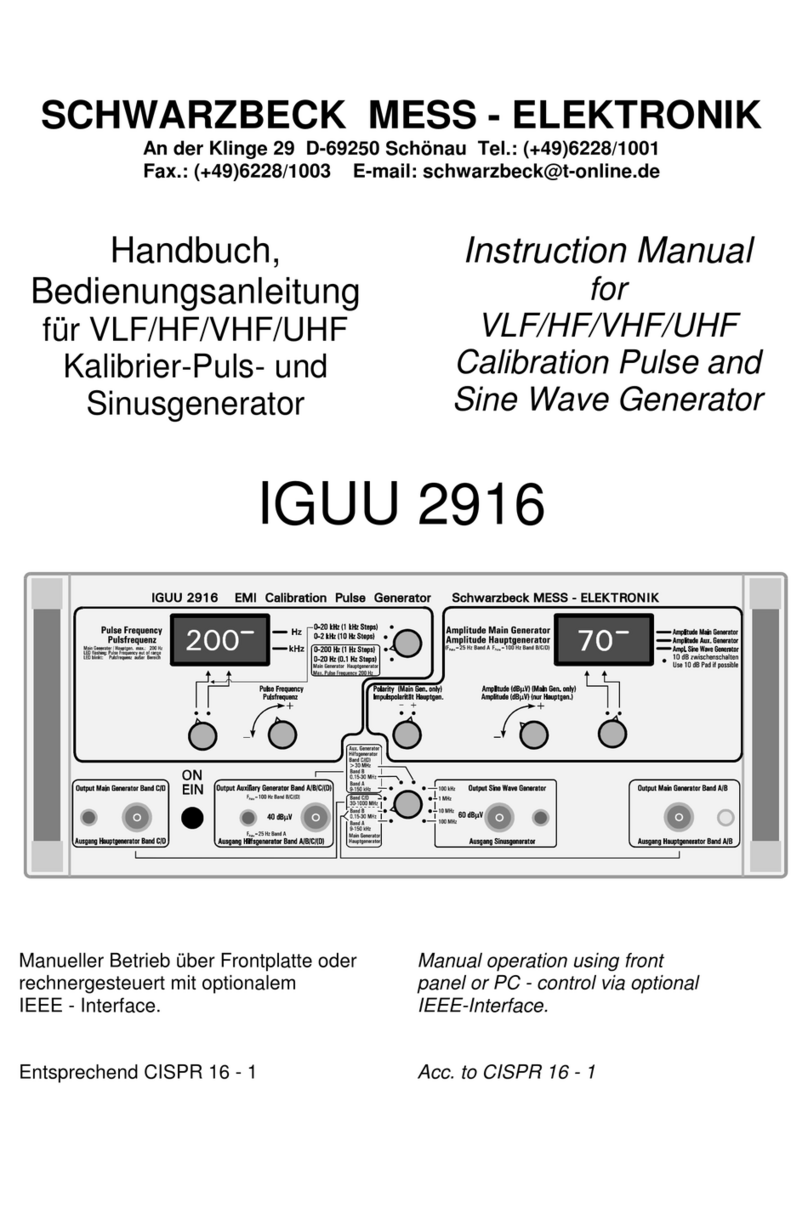
Schwarzbeck
Schwarzbeck IGUU 2916 instruction manual
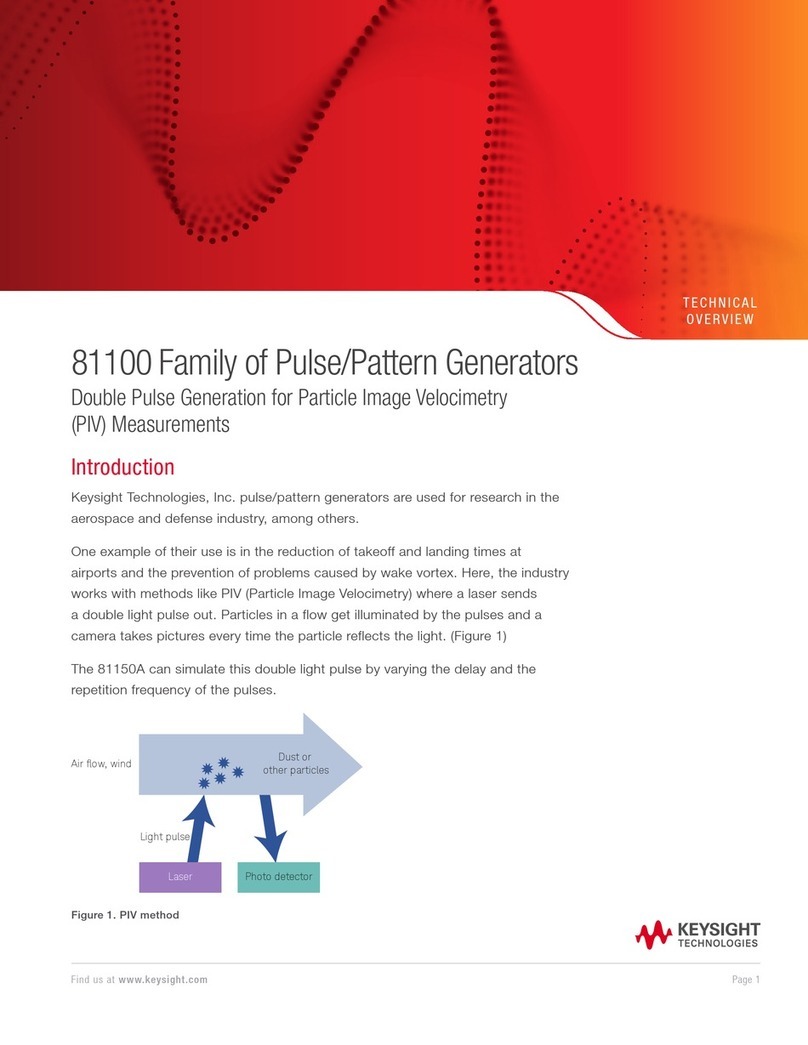
Keysight Technologies
Keysight Technologies 81100 Series Technical overview
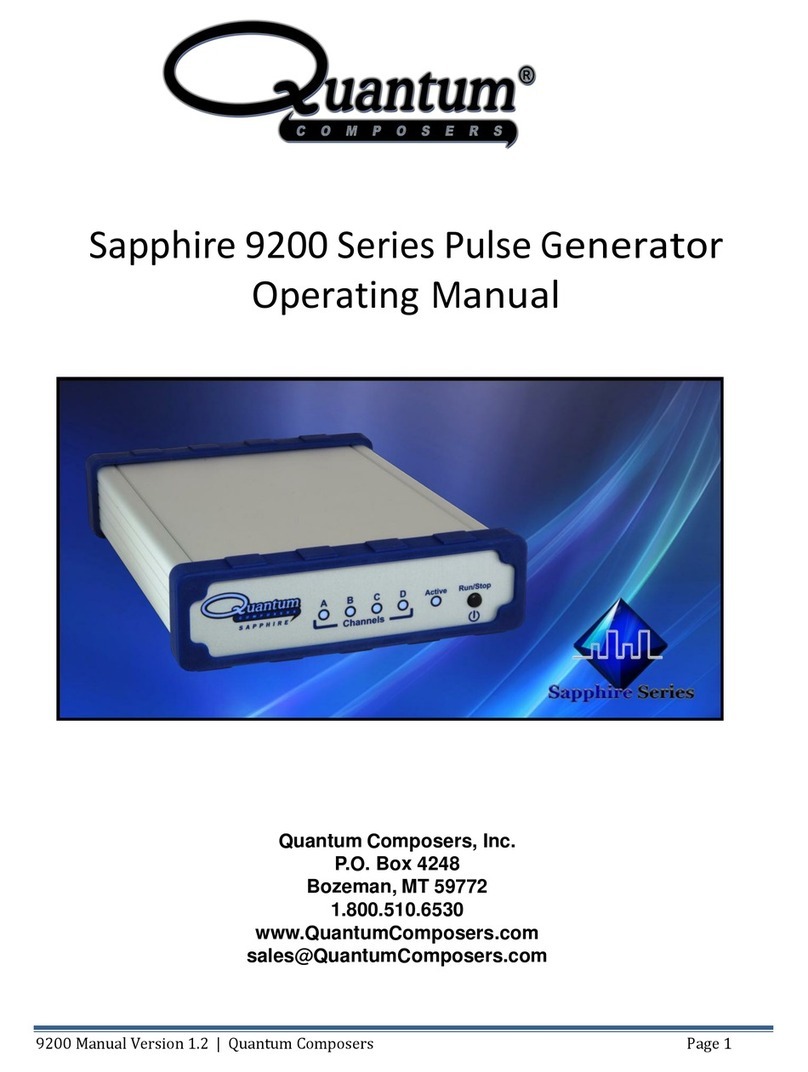
Quantum Composers
Quantum Composers Sapphire 9200 Series operating manual

HP
HP 8110A Service guide
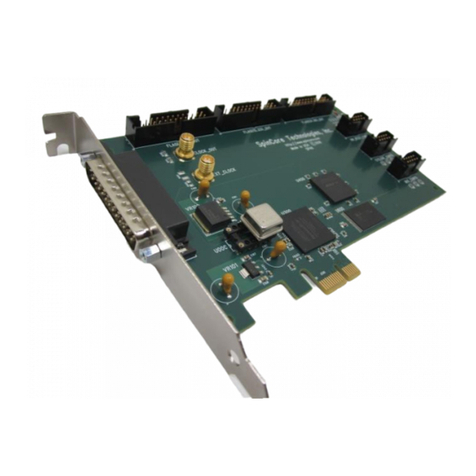
SpinCore Technologies
SpinCore Technologies PulseBlaster owner's manual
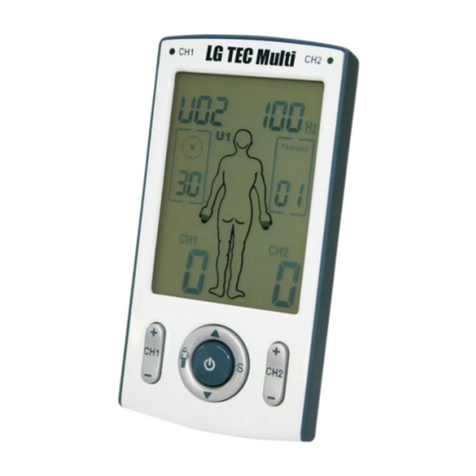
LG
LG TEC Multi instruction manual
